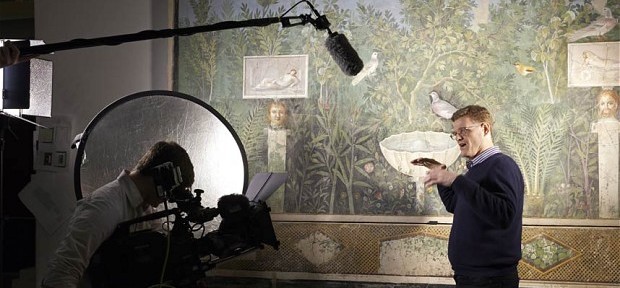The hot exhibition ticket in London is the British Museum’s Pompeii show. For the rest of the summer, many dates have only late-evening tickets available. So the expanding reach of cinema experience of live events (previously confined to opera, dance and theatre) is very welcome.
We open to hustle-bustle music, to get us in the mood for our guided exhibition tour, and a crane-shot zooms down on Peter Snow at the front entrance, telling us how exciting this all is. Then another introduction breathlessly itemises the number of people involved in putting the show together. And Neil MacGregor, the Museum director, appears for a third introduction, again stressing numbers. It’s as though they don’t trust their material.
Which is odd, because the material is fabulous. Telly dons abound – Mary Beard, Bettany Hughes – as well as the chef Giorgio Locatelli, who gives a recipe for stuffed dormouse. “Just like rabbit!” he cries. “Use pine-nuts”, he encourages the appalled Peter Snow.
The brilliant Andrew Wallace-Hadrill, director of the Herculaneum Conservation Project, enthuses about sewer archaeology to the still-appalled Snow: “The Herculaneum sewers are an absolute joy,” he cries. And it is a joy that he can make us understand why, as he shows the jewels, ceramics, even statues that slipped down the drains.
Bettany Hughes takes over the appalled slot, as Mary Beard looks at a winged phallus windchime. We don’t know what the phallus represented, she makes clear; she lists possibilities, but is good on the great uncertainty that is the past.
Hughes then warns us to avert our gaze as we get to a statue of the god Pan having sex with a goat. (“How do you make love to a goat?” she asks nervously. Very carefully indeed is the obvious, but unspoken reply.)
After a reconstruction of the eruption and the pyroclastic surge that engulfed the two towns in volcanic ash, the final display, a collection of possessions found on the beach at Herculaneum, is heart-breaking: a lantern used as the fleeing crowds stumbled around in the night that descended at midday, a key to a house to which its owners will never return.
Peter Snow, no longer appalled, is now thrilled. “Isn’t it terrible?! What exciting things!” he crows. “An intense human tragedy,” he adds, chuckling over the plaster cast of a couple and their two children in their death-throes.
With gracious restraint, the exhibition’s curator Paul Roberts provides a measured and touching response to this curious empathy-bypass: the tragedy, he explains to Snow and us, enabled those who died so suddenly to live on, to share their lives with us 2,000 years later.
The camera could linger longer on the exhibits, and it would be nice if, every now and again, the talking heads just stopped talking and let us look. But the British Museum’s Pompeii is an extraordinary achievement, a fine combination of scholarship and showmanship.
That it can, via Pompeii Live, reach a wider audience can only be a good thing.
